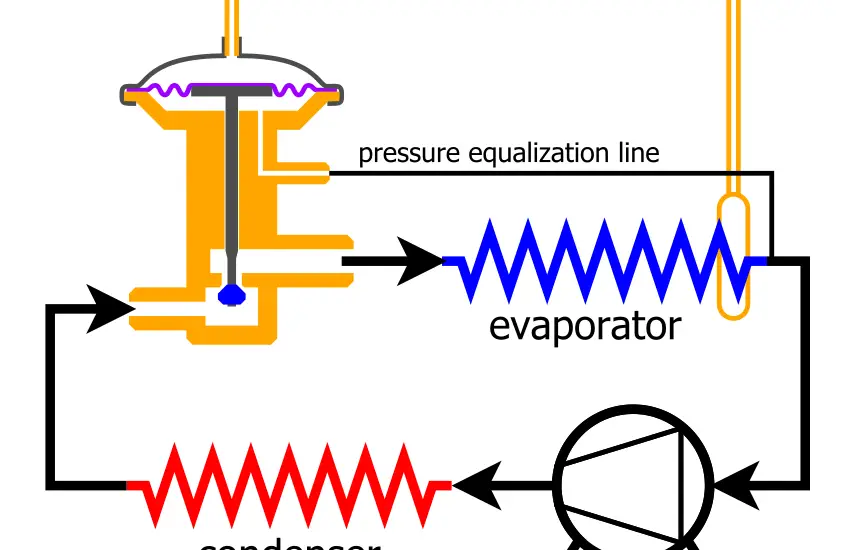When it comes to the “TXV vs Piston” discussion, understanding the role each plays in your HVAC system is vital. In this guide, we’ll dissect each one to help you make an informed choice tailored to your needs.

Table of Contents
Understanding the Basics
In any HVAC system, metering devices are essential components that regulate the flow of refrigerant between different sections of the system, essentially guiding it from the condenser to the evaporator coils. Both TXVs and pistons perform this role, but they do so in different ways which affect the system’s performance.
Understanding their operation is foundational in grasping the “TXV vs Piston” debate.
What is a TXV?
A TXV, or Thermostatic Expansion Valve, is a sophisticated tool designed to control the amount of refrigerant flowing into the evaporator based on the current cooling demand.
It gauges the temperature of the evaporator coil and the pressure in the system, adjusting accordingly to maintain optimal conditions.
Its ability to respond to fluctuating conditions makes it a popular choice for enhancing efficiency in HVAC systems.
Benefits of Using a TXV
Utilizing a TXV in your HVAC system offers a range of benefits, including improved energy efficiency as it adjusts to the cooling needs, resulting in less wasted energy.
Moreover, it can enhance the lifespan of your system by avoiding excessive wear and tear on the components.
Drawbacks of Using a TXV
While TXVs offer precise control, they come at a higher upfront cost.
In addition, they entail a more intricate installation process and may require more frequent maintenance compared to piston systems.
What is a Piston?
The piston is a type of fixed orifice metering device that is responsible for regulating the refrigerant flow in your HVAC system.
Unlike a TXV, it operates at a fixed rate, meaning it allows a consistent amount of refrigerant through, irrespective of the system’s conditions.
This type of system is generally more straightforward, without the ability to modify the refrigerant flow according to the system’s demands.
Benefits of Using a Piston
Piston systems come at a lower upfront cost, making them a budget-friendly option.
They are also easier to install and require less maintenance compared to TXVs.
Pistons can be a great option if you’re looking for a simple, cost-effective solution for your HVAC system.
Drawbacks of Using a Piston
Despite their affordability, pistons are less efficient than TXVs as they cannot adjust to varying load conditions. This could result in higher energy bills over time.
Furthermore, their fixed operation might not offer the optimal performance needed in fluctuating environments.
TXV vs Piston: Key Differences
The distinction between TXV and piston metering devices is pivotal to determining the suitability and performance of your HVAC system. Here’s a deep dive into their primary differences:
Adjustability
One of the standout features of a TXV is its ability to adjust the refrigerant flow according to the cooling demands of the system. It uses sensors to gauge the temperature and pressure in the evaporator coil, thus modulating the flow accordingly.
On the other hand, a piston does not have this dynamic capability. It operates on a fixed orifice principle, delivering a consistent amount of refrigerant, regardless of the system’s requirements.
This means that in fluctuating conditions, a TXV provides more efficient cooling while a piston may either overcool or undercool.
Efficiency
The TXV’s adjustability inherently grants it higher efficiency, especially in varying environmental conditions. It ensures that the HVAC system is not using more refrigerant than necessary, leading to energy savings.
Conversely, the piston’s consistent flow can sometimes lead to inefficiencies, especially when the cooling load requirements change frequently.
Cost
When considering upfront costs, pistons generally come off as more affordable. They are simpler devices, leading to lower manufacturing and selling prices.
However, a TXV, given its complex mechanism and the added benefits of efficiency, tends to be pricier. Yet, over time, the energy savings afforded by a TXV can offset its initial higher cost.
Check out these other related articles…
How to Adjust Superheat and Subcooling: An Easy Guide
TXV HVAC: Your Comprehensive Guide
Bad TXV Valve Symptoms: Detecting & Resolving Early Signs
What is TXV Valve? Comprehensive 411 Guide
How Does a TXV Work? Your Easy 411 Guide
When is a TXV Valve Needed: Comprehensive 411 Guide
Function of Thermostatic Expansion Valve in Refrigeration System
Choosing Between TXV and Piston
Now that you’re equipped with the key differences between TXV and piston, the question arises: which one should you choose for your HVAC system? This decision is influenced by multiple factors, each playing a role in shaping the overall performance and longevity of the system.
Operating Conditions
If your HVAC system is set up in an environment with frequently changing temperatures or variable load conditions, a TXV would be more suitable. Its adaptability ensures that it responds appropriately to varying demands.
However, for systems in more consistent and stable conditions, a piston can be sufficient, as its fixed operation might not cause significant inefficiencies.
Budget
Your available budget is undeniably a major factor in this decision. If you’re working with limited funds and need an immediate, cost-effective solution, a piston can be an attractive choice.
However, if you’re looking at the long-term performance and can invest a bit more upfront, a TXV can offer returns in the form of energy savings and potential extended system lifespan.
Maintenance
Given their more complex nature, TXVs can occasionally require more maintenance checks and potential adjustments. This could translate to slightly higher maintenance costs over time. In contrast, pistons, being simpler devices, usually require minimal upkeep.
However, always remember that regular maintenance is crucial for any HVAC component to ensure optimal performance and prevent potential issues.